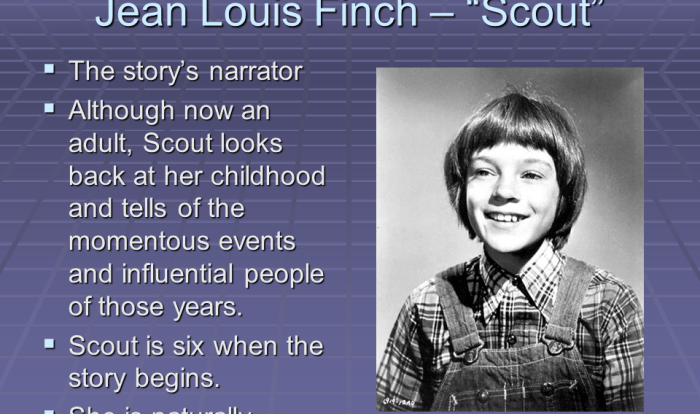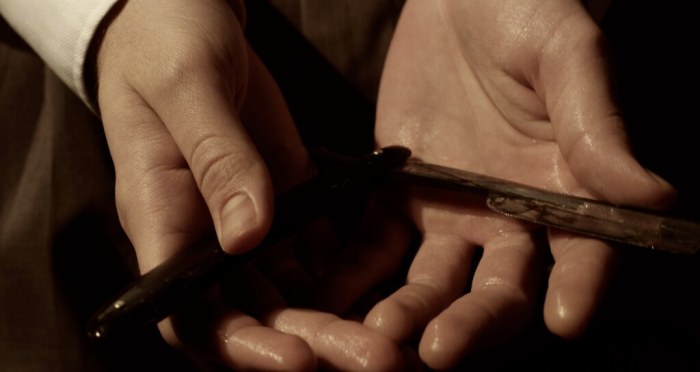Embark on a literary journey with our Crucible Act 1 Study Questions. Dive into the depths of Arthur Miller’s iconic play, exploring the complexities of characters, themes, and historical significance.
Delve into the Puritanical world of Salem, Massachusetts, where accusations of witchcraft ignite a firestorm of suspicion and fear. Witness the unfolding drama as characters grapple with guilt, hypocrisy, and the dangers of mass hysteria.
Themes and Motifs
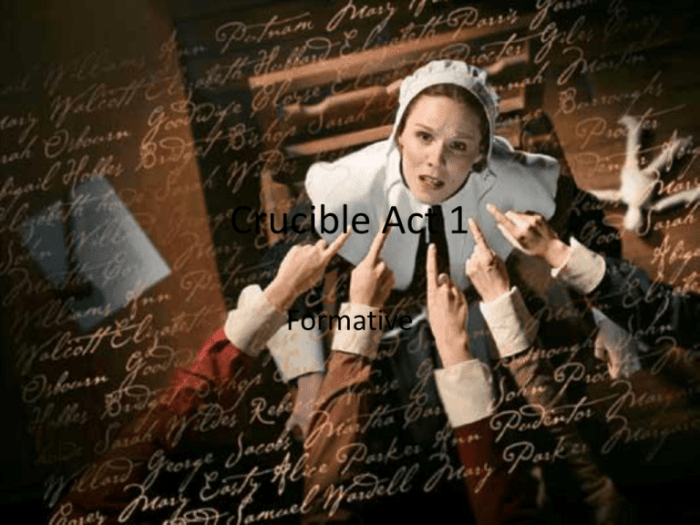
The Crucibleexplores profound themes through its characters and events. Guilt, hypocrisy, and the dangers of mass hysteria take center stage, revealing the destructive nature of fear and the fragility of justice.
Guilt
The play delves into the corrosive effects of guilt. Abigail’s false accusations stem from her desire to hide her affair with John Proctor. Her guilt manifests in her relentless pursuit of those she perceives as threats, leading to the unjust imprisonment and execution of innocent people.
Hypocrisy
The community of Salem is rife with hypocrisy. The leaders, who claim to uphold righteousness, engage in secret sins and condemn others for actions they themselves commit. Reverend Parris’s greed and Abigail’s lust are glaring examples of the hypocrisy that permeates the society.
Mass Hysteria
The play portrays the dangers of mass hysteria and the ease with which fear can spread. The accusations of witchcraft ignite a wildfire of paranoia, leading to a frenzy of persecution. The mob mentality overrides reason and justice, demonstrating the destructive power of unchecked fear.
When studying the complexities of “The Crucible” Act 1, don’t forget to check out the Big Ideas Math 8.2 Answer Key for additional insights. By exploring both resources, you’ll gain a comprehensive understanding of the play’s themes, characters, and historical context, enhancing your appreciation for this classic work of literature.
Motifs
The play employs several motifs to reinforce its themes. Fire, a symbol of both destruction and purification, is used to represent the consuming nature of the witch hunt. The devil, often invoked as the source of evil, serves as a metaphor for the darkness that can lurk within human hearts.
Symbolism and Foreshadowing
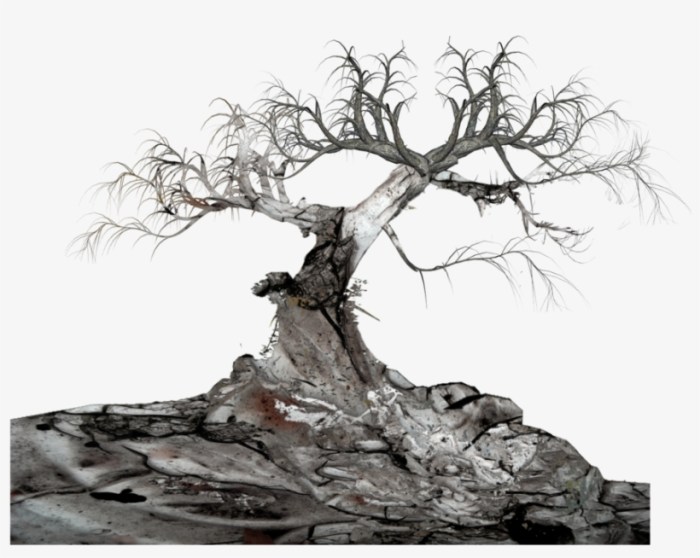
The Crucible employs potent symbols and foreshadowing to enhance its themes and create a haunting atmosphere. These elements contribute to the play’s exploration of guilt, justice, and the dangers of mass hysteria.
Symbolism
- The Crucible:A symbol of the town’s moral crisis, representing the trials that test the characters’ souls and reveal their true nature.
- The Forest:A place of darkness and temptation, where the characters’ secrets and fears are exposed, and where evil lurks.
- The Bird:A symbol of freedom and innocence, its death foreshadowing the loss of hope and the impending tragedy.
Foreshadowing
- Abigail’s accusations:Her false accusations against innocent people hint at the dangers of unchecked accusations and the potential for mass hysteria.
- Parris’s fear of losing his authority:His willingness to accuse others to protect his position foreshadows the lengths people will go to maintain power.
- The arrival of Hathorne and Danforth:Their presence foreshadows the intensification of the trials and the ultimate tragedy that awaits the accused.
Dramatic Structure
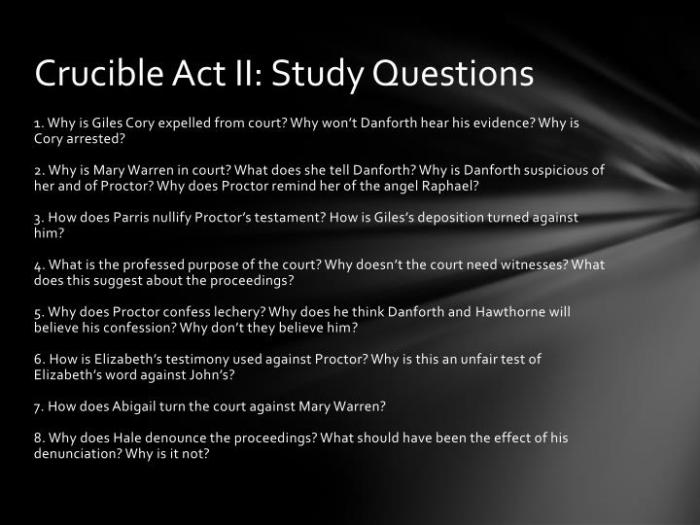
Arthur Miller’s The Crucibleis a play with a tightly constructed dramatic structure that builds tension and suspense leading to a tragic resolution.
Rising Action
- Abigail Williams accuses several innocent people of witchcraft, sparking a witch hunt in Salem.
- The accusations spread rapidly, and the town is gripped by fear and paranoia.
- John Proctor, a respected farmer, tries to expose Abigail’s lies but is met with resistance.
Climax
- The climax occurs when John Proctor is arrested and sentenced to death for witchcraft.
- Abigail’s lies are finally revealed, but it is too late to save Proctor.
- Proctor’s execution marks the peak of the play’s tension and tragedy.
Falling Action, Crucible act 1 study questions
- After Proctor’s death, the witch hunt gradually subsides.
- Abigail flees Salem, and the town begins to heal from the trauma.
- Reverend Hale returns to Salem and preaches a sermon about the dangers of mass hysteria.
Resolution
The play ends with a somber note as the town reflects on the lessons learned from the witch hunt.
Miller uses dramatic devices such as irony and suspense to create a compelling story. The irony of the situation lies in the fact that the people of Salem are accusing innocent people of witchcraft while being unaware of the true evil in their midst.
Miller also uses suspense to keep the audience on the edge of their seats. The play’s rising action builds tension and suspense, leading to the tragic climax. The audience is left wondering until the very end whether Proctor will be able to expose Abigail’s lies and save himself and the others.
The play’s ending is significant because it shows the devastating consequences of mass hysteria and the importance of standing up for what is right, even in the face of adversity.
Quick FAQs: Crucible Act 1 Study Questions
What is the significance of the crucible in the play?
The crucible symbolizes the intense pressure and scrutiny that the characters face, both physically and emotionally, as they are tested and their true natures are revealed.
How does the play explore the dangers of mass hysteria?
The play depicts how fear and superstition can spread rapidly through a community, leading to false accusations and unjust punishments.
